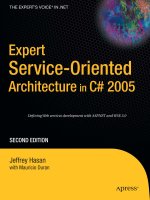Distribution Architecture: Hardened Connectors vs. Field Splicing
Bạn đang xem bản rút gọn của tài liệu. Xem và tải ngay bản đầy đủ của tài liệu tại đây (164.88 KB, 4 trang )
Distribution Architecture:
Hardened Connectors vs. Field Splicing
WHITE PAPER
Making cost-sensitive decisions about deploying FTTX architectures requires service
providers to not only look at initial installation costs, but to also peer into the future
regarding operational and maintenance expenses following service turn-up. Cost
modeling allows the deployer to review the financial benefits of their design choices
before deployment begins. This paper specifically addresses the cost comparisons
between using hardened connectors vs. splices in two basic areas of the FTTX network
– the distribution plant and drop cable portions.
Cost savings can be achieved on both sides of the service terminal by installing
hardened connectors. Although most network architects agree that hardened
connectors are optimal for the drop side of the service terminal, many are unaware
that the cost on the distribution side is also at cost parity or, in many cases, lower
when using connectors in lieu of splicing. The result is an overall lower installed cost
for the FTTX network as well as tremendous operational savings over the life of the
network.
Large cable and splices
In many typical FTTP architectures, a very large distribution cable containing 48 to 216
individual fibers is deployed from the Fiber Distribution Hub directly to the service
terminal. The service terminal could be a splice case, a pedestal, a hand hole, or
mounted on a pole. In the case of a spliced network, between one and 12 fibers will
be prepared inside the service terminal for connecting to drop cables that service each
individual home.
The remainder of the distribution cable will continue to the next service terminal
where the next one to 12 fibers will be split off and made available for service. Each
time service is ready to turn up at a particular home, a technician will go to the
terminal, cut off the appropriate length of drop fiber cable from a large spool, and
pull the cable from the terminal to the optical network terminal (ONT) on the side of
the home, or vice versa, and splice both ends.
This requires two sets of workers – a construction crew to pull the cable to each
location and a splice technician to prepare the cable for splicing. The splice technician
will need to visit each individual service termination to prep out the distribution cable,
even if splicing is not required at that time. It also requires another trip to the service
terminal by a technician each time a drop cable is ready to be spliced in to provide
service to a home. It’s easy to see that a typical spliced approach requires more overall
manpower costs and numerous trips to the service terminals by a larger number of
experienced technicians. All of this adds to the start-up costs for the FTTX build-out.
Distribution Architecture:
Hardened Connectors vs. Field Splicing
Distribution Architecture: Hardened Connectors vs. Field Splicing
Page 2
A more economical approach
Using a hardened connector approach on the distribution
side of the service terminal is less costly and requires far
fewer splice technician deployments. In this architecture,
which incorporates ADC’s new OmniReach™ Multi-Fiber
Service Terminals (MSTs), smaller cables--up to 12-fibers
each--are extended from a centralized splice location to
each service terminal. This eliminates running very large
cables and accessing those cables at numerous locations.
Even though the number of splices is about the same, all
splices are done at one location, greatly reducing overall
splicing costs. Typically, a large portion of splice cost is in
the set-up. But with a central splice point, the splice
technician sets up one time and splices as many as 12
smaller cables onto the distribution cable.
Additionally, there are no splice cases required at the
service terminal, making the hand holes or pedestals that
store the service terminals much smaller. This is beneficial
from both a materials and installation standpoint. Also,
many municipalities prefer smaller, less obtrusive
pedestals or smaller hand holes that are easily placed and
less expensive.
A cost model comparing the installation costs of the
traditional spliced FTTX architecture with one that
incorporates MST hardened connector technology in a
192-home subdivision is as follows: Using the MST
model, cable costs decreased by over 85% due primarily
to the cable now being included in the terminal costs.
The cost of pulling fiber cables decreased by about 25%
and splicing costs were about 70% lower. Even though
the MST approach added additional costs for service
terminals, the overall cost was significantly lower for the
distribution side of the network – approximately 19%
less per home passed.
The drop cable portion of the network – between the
service terminals and the ONTs – also reaps many
advantages through a hardened drop connector
approach. The technician can simply use a pre-
connectorized drop cable – pre-connectorized at both
ends in the factory and cut to specific lengths – to install
between the service terminal and the home. These cables
can be installed by any technician, possibly the same
person connecting the electronics at each home. This
greatly reduces the cost of drop cable installations in
terms of time and skill level. A technician simply has to
clean the connector faces at each end and plug them in.
The overall cost of using factory-connectorized drop
cables in place of spliced bulk drop cable was at least
25% less. Since service providers can realize a combined
savings of nearly 25% in the entire OSP portion of the
fiber plant, the business case for the architecture that
incorporates MST hardened connectors is compelling. But
there’s more – additional operational savings over the life
of the network should also be considered.
Savings now and later
The operational cost savings gained from having a
connectorized FTTX infrastructure becomes evident in
terms of faster service turn-up, ease of maintenance and
troubleshooting, the need for fewer splice
technicians/equipment, and overall fewer truck rolls. But
through extensive cost modeling, ADC is showing that
the cost savings can be achieved at the onset of building
the network.
Installation cost modeling has shown that a spliced
approach is far more expensive than a hardened drop
connector approach. Splicing is simply a much more
expensive undertaking without a centralized splicing
location. More locations, more splices, and the need for
more splice technicians greatly increases initial installation
costs in the network.
In the hardened drop connector system, troubleshooting
can be done at the service terminal simply by unplugging
a connector. The spliced approach requires breaking a
splice or going directly to the side of the home to
investigate problems. There is less need for splicing
equipment, particularly in larger installations.
Despite arguments that connectorized approaches result
in more optical loss and also require more inventory and
slack storage provisions, the data outlined above still
reaches the same overall conclusion – the hardened drop
connector approach incurs lower overall installed costs
for the FTTX network.
Spliced Approach
Hand-Hole Costs $ 10,000.00
Cable Costs $ 15,000.00
Cable Placing Costs $ 75,000.00
Splicing Costs $ 9,072.00
Terminal Costs $ 0.00
Total Costs $109,072.00
Cost/ Home Passed $ 568.08
Hardened Drop Connector Approach
Hand-Hole Costs $ 11,194.00
Cable Costs $ 1,538.00
Cable Placing Costs $ 56,650.00
Splicing Costs $ 2,988.00
Terminal Costs $ 16,072.00
Total Costs $ 88,442.00
Cost/ Home Passed $ 460.63
Specific cost model based on a phased project for a 192 home subdivision, featuring eight homes
per block.
ADC Telecommunications, Inc., P.O. Box 1101, Minneapolis, Minnesota USA 55440-1101
Specifications published here are current as of the date of publication of this document. Because we are continuously
improving our products, ADC reserves the right to change specifications without prior notice. At any time, you
may verify product specifications by contacting our headquarters office in Minneapolis. ADC Telecommunications,
Inc. views its patent portfolio as an important corporate asset and vigorously enforces its patents. Products or
features contained herein may be covered by one or more U.S. or foreign patents. An Equal Opportunity Employer
103777AE 11/06 Revision © 2005, 2006 ADC Telecommunications, Inc. All Rights Reserved
Web Site: www.adc.com
From North America, Call Toll Free: 1-800-366-3891 • Outside of North America: +1-952-938-8080
Fax: +1-952-917-3237 • For a listing of ADC’s global sales office locations, please refer to our web site.
WHITE PAPER









